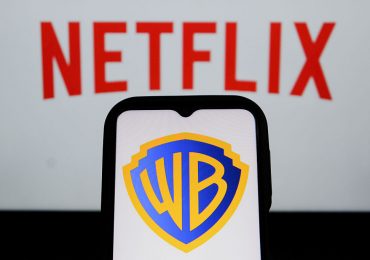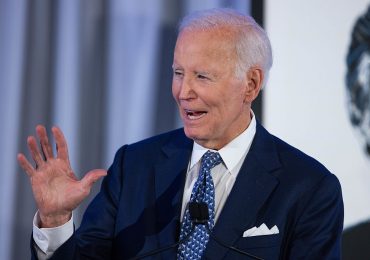In an exclusive interview with TIME, San Francisco Federal Reserve president and chief executive Mary Daly said that the explosion of artificial intelligence (AI) could improve the labor market in the long-term and make workers more productive, even as workers fear the rising technology will change or eliminate their jobs.
“Jobs are being created, as well as jobs being replaced,” Daly said of AI. “If we can get people to upskill or reskill to take the jobs that are being created, we’ll have a very successful and growing economy. But that’s the burden on us—to make sure that everyone can participate in this changing technological development.”
[time-brightcove not-tgx=”true”]
TIME sat down with Daly at the Aspen Ideas Festival on June 28 to discuss the nation’s monetary policy, a potential softening in the labor market, the role of AI in the workforce, and more.
This interview has been condensed and edited for clarity.
TIME: Tell me a bit about your role as a Federal Reserve Bank president. What does your day-to-day look like?
Mary Daly: I have many different responsibilities. I have about 2,000 employees that work in five locations and we cover the nine western states. We do everything in those businesses and facilities from processing cash to making sure currency is clean and efficiently processed to bank supervision and information technology. Then, of course, [we also do] economic research and policy and community engagement. With nine states, it’s a large geography. So another part of my responsibilities is just get out in the district and talk to people, talk to CEOs. I work with community groups and government officials and worker groups to understand the lived experience in the areas they are in. [Then I’m able] to bring that insight and intelligence back to my decisions when I make monetary policy.
The monetary policy component is studying, learning, and analyzing—and going to D.C. for the FOMC meetings. Our work is only as good as the American people’s ability to understand it. Trust is one of our most important tools as we navigate to get to price stability and full employment. And so that’s a big part of my job as well.
I know you’re very passionate about Zip Code Economies. How does it factor into your role as a Federal Reserve Bank president?
So I started Zip Code Economies [a podcast] some years back, because I recognized something really important that didn’t ring true. When I travel all around the district and the United States, when I get to the zip code level—the community level—I see people who have hope, who maybe do not have the circumstances they want today, but they work in a community to make their circumstances better. When you read the economics research, it says that zip code is destiny. So there’s this big gap between how people living in the zip codes feel about their own lives and futures and how economists say zip code is destiny.
We set out to ask people: “What does your community mean to you?” And what we found is that…when you go and talk to people, they tell you that yes, things can be challenging. Here’s our way of making it better. Here’s what makes our situation better. We’re trying to leave the world better than when we found it. Here’s how we’re doing that. I wanted to tell those stories. So now Zip Code Economies is just a place where I shepherd the voices of others and they tell their own stories.
Pivoting to interest rates, do you think the Fed’s next move is going to be a hike or a cut? And how are you thinking about that policy moving forward?
Let me start with how we are thinking about the policy because it’ll explain why you won’t hear me talking about what I’m doing at the next meeting [on July 30]. There’s many more pieces of data that come in before we next meet. So we’re at a point right now where the risks to the economy are roughly balanced on inflation and on the labor market. We have two mandates: full employment and price stability. For a long time now, we’ve been fighting to get inflation down. Employment has been good, the labor markets have been healthy. We’re making progress on that journey. Monetary policy is working: the interest rates are higher, and you’re seeing that put a slowdown in the economy and bring inflation down.
We have to think about also making sure that we don’t give people low inflation and take away full employment. Because people want both things:price stability and jobs. What we’re doing is remaining thoughtful as we look at the data. We think about how to get confidence about where the economy is headed, and make policy adjustments only when we feel confident. Our policies are in a very good place right now so we don’t need to act urgently. We need to act thoughtfully. And so I don’t have a view of what we’ll do next time that’s so well formed that I would state it because it depends on how the economy evolves. I actually said earlier this week that right now optimal policy is conditional policy. If inflation stays high and sticky, then we’ll hold the rate for longer. If inflation comes down as we project, then we’ll gradually normalize. If inflation comes down more rapidly than we expect or the labor market starts to weaken more than expected, then we will make adjustments more rapidly. So those are the scenarios and the data will tell us which one we’re seeing come out to play, and then we will react accordingly.
Read More: Will AI Take Your Job? Maybe Not Just Yet, One Study Says
How confident are you that the Fed will get interest rates back down to the 2% target without causing a recession?
Every month of new data we get that says inflation is gradually coming down, and that policy is working and that the labor market remains solid. It’s still a good labor market. It’s just not as, you know, frothy as it was. That’s what my employers tell me. It feels like employees come, they don’t leave in two weeks to go find the extra dollar at the next place. They stay. They can grow their careers here. So every month of data we get that says those are still our conditions makes it more likely we’ll be able to achieve our goals of bringing inflation down as gently as we can. But I’d never declare victory until we’re really there, so there’s more work to do.
Housing is a big factor keeping inflation high right now. What are you hearing from businesses and communities in the 12th District—and what does this suggest about housing and rent prices?
What I’m hearing now and it’s not just in the 12th District, it’s across the nation… Housing is a problem everywhere. In fact, there’s this really interesting statistic from the Cato Institute that changed the way I understood how imbalanced the housing situation is. It says that 87% of Americans are worried about the cost of housing. They’re worried about their grandkids not being able to live near them because their kids can’t live where they grew up. They’re worried if they’re new homebuyers, worried if they live in rural areas and they can’t afford it. It doesn’t matter where you go, how old you are, what political persuasion you come from—everyone’s worried about housing. And interest rates have stopped the housing prices from appreciating as much as they were, but ultimately, interest rates can’t solve the fundamental problem. The fundamental problem is that we have too little housing and too much demand. Too little supply, too much demand means higher price levels on housing.
Are you concerned about further softening in the labor market, and how AI could impact the labor market in the longer term?
In terms of further softening, as the economy slows, we can expect the labor market to slow accordingly—to slow with the economy. That’s how monetary policy works: Interest rate goes up, the economy slows. As the economy slows, the labor market slows. And we are at a point now where some of the easy wins we got with inflation coming down without much of a disturbance to the labor market [or] the unemployment rate—those benign outcomes could be less in our future, but it’s too early to tell. So I wouldn’t say I’m worried about the labor market, but I’d say I’m definitely watching the labor market.
Now in terms of AI, that’s a different issue. That’s less about the slowing economy and more about technology. The important thing to remember when you think of AI is that technology’s always changing. You know, about five years ago, it was robotic process automation that people were very worried about. Well, obviously, we automated it with those types of technologies and we still have employment. We’ve had technological progress—the computer revolution, the Internet—all of that came and the unemployment rate stayed roughly below 5%. So jobs are being created, as well as jobs being replaced. And so the key is: Which tasks and jobs are being replaced? Which ones are getting augmented, making people more productive? And which ones are being created? The way the economy functions is if we can get people to upskill or reskill to take the jobs that are being created, we’ll have a very successful and growing economy. But that’s the burden on us—to make sure that everyone can participate in this changing technological development.
Read More: How to Make AI Work for You, at Work
You’ve said that companies—predominantly in tech—need to be more actively making workers return to the office in San Francisco. Are the current remote and hybrid arrangements weighing on the economy there and more broadly, in the U.S.?
In the economy in San Francisco or any city where there’s a lot of office vacancy or where people are worried about the vibrancy of the urban corridor…they say tourism is coming back. And that’s really good, but [tourism is] a nighttime business. The day businesses—like the lunch business—are all workforce [dependent]. And of course, to make a vibrant city one that feels like there’s liveliness in it, it is about bringing your employees back to work at least part time. I’m not saying bring them back five days a week. We need to evolve. But I think it’s important for the vibrancy of our cities to have people participate in the vibrancy of our cities.
But here’s something that I think is even more important, and it’s nationwide: we were talking this morning [at the Aspen Ideas Festival] about AI and what it can do well. It can actually displace some of the entry level jobs that people start doing when they’re young and then they build themselves up to take on some more challenging roles. You have to practice getting those skills, human capital experience, but also EQ skills. How do you interact with people? How do you manage people? How do you do these things if we don’t come back to the office sometimes? Then all these young, new, career folks, they are going to have a disadvantage in terms of learning those skills. So we come to work three days a week in San Francisco and in the Fed, and we do it in all our areas because we believe that is our obligation and responsibility to help all generations feel like they can reach their potential down the road. So that’s part of the virtuous cycle that we’re trying to create in our economy. Is it hurting our economy? You can’t see the signs of that today. But a decade from now, when all of our emerging leaders have not had the experience of being there and learning how to lead in person ever, then I think that’s a challenge.
I want to stay on this remote work theme just a little bit longer. Some working parents and those with other caring responsibilities—often women—say that these working arrangements have been greatly beneficial for them. Would forcing a return to in person work disproportionately affect women?
You know, we haven’t found that. So let me give you some examples of how it’s not just that way. Say we said that we’re not going to do all remote work, we’re going to have five days a week, eight hours a day, very prescriptive hours. Well, that’s really hard on lots of people whose lives don’t have that kind of flexibility. They have to sacrifice things. But if you say to people, you come in two, three days a week, and the hours in which you come in, just try to be there in certain hours where your teams are there, try to have focus days, etc., well then you can get some of the proceeds of being in the office and helping advance your career. Women and other minorities in the workplace, especially in leadership roles, they will be disadvantaged if they never participate either. But it is not meant and doesn’t have to be at the expense of having flexibility.
What if our model of the workplace was: Flex for your day, flex for your life. For workers who don’t have to be there every day, being able to flex so that if you have a soccer game or you have a doctor’s appointment for your kid or [have to] care take with a parent or a neighbor, well then you have that flexibility, but you’re still participating.
And I’m sure you get asked this question a lot. Are you worried about a “doom loop” in San Francisco?
No, I’m not worried about a doom loop. In fact, I think doom loop is something that describes a city and an economy without assets, without energy, and that just has folded up its tent and that’ll be the end. There aren’t many American cities that have that right now and San Francisco is definitely not one of them. There are talented people. There are new businesses coming and putting themselves in the San Francisco area every week. It’s a beautiful area. It’s an area of entrepreneurship and innovation. It’s got a certain freedom to it which allows people to innovate and think outside of the box. And frankly, that’s what we need.
That doesn’t mean we don’t have problems. We have a very large housing shortage. We have some infrastructure in terms of roadways and repairs that need to be taken care of. And we have just the idea that people are still not sure if it’s going to be OK in San Francisco. But tourism’s back. We have people coming in partaking in the beautiful area, and now it’s really about bringing people back, getting them excited. But there are many people who are bullish on San Francisco. I’m one of them and that doesn’t mean it’ll be ready to go back to normal tomorrow. But you know, San Francisco has reinvented itself so many times, even in the time I’ve lived there [since 1996]. We’ve gone through many cycles, and every single time we thought it was the end of San Francisco: the dot com [bubble], then the financial crisis, then the pandemic. It’s never happened yet.
Leave a comment








